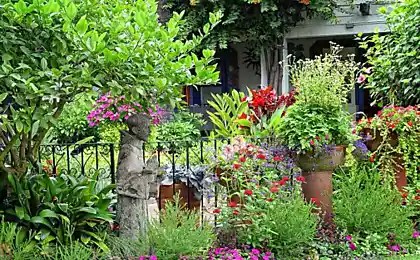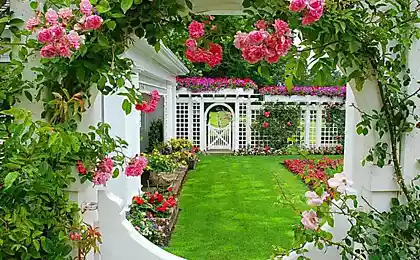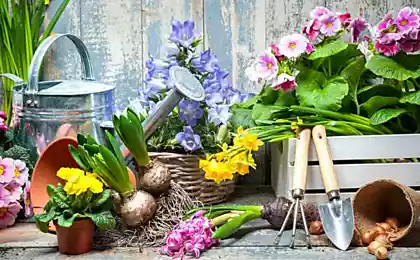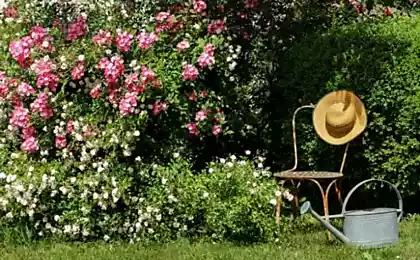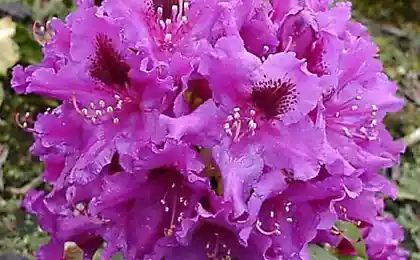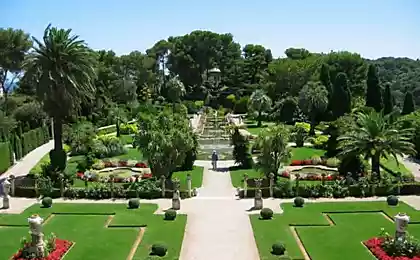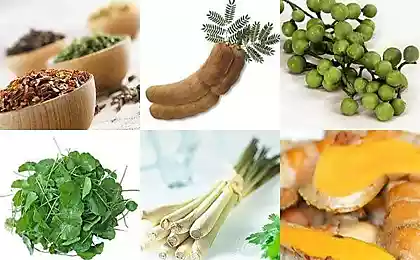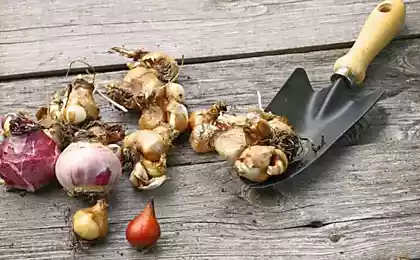660
10 plants for your garden blooming in July
That's the middle of summer – July, the peak of the hot, Sunny days that reign Supreme floral annuals. Blooming marigolds, verbena, sweet peas, nasturtium, sweet tobacco, purslane, morning glory and other participants in the July flower dance. Great in this time of bigleaf hydrangea with large balls of flower buds, from afar attractive campsis root, which deftly climbs vertically with their roots-suckers, and every day more and more dissolve your "wax" flowers. List of plants flowering in July, you can continue to infinity, but once again, we chose 10 popular leaders. Begonia Begonia loved and cottagers and craftsmen-decorators, who often use it in the floral decoration of the villas, ceremonial places, parks and streets. And everywhere it finds its place, transforming the hidden corners. Begonia Vale of eternal blossoms looks beautiful in flowerbeds, perennial borders, arabesques; it is used as a container culture.
Begonia Vale of eternal blossoms, or sagacity (Begonia x semperflorens) is a perennial herbaceous plant from the same family of begonia, grown often as an annual, 15-30 cm tall with succulent stems gustovataja. The leaves are large, heart-shaped, shiny green and bronze varieties. The flowers are small, with a diameter of 3 cm, white, pink, red, simple and double. Flowering is very long, until frost.Features of cultivation. Begonia light-requiring, but can tolerate partial shade, not picky about soil, but luxurious blooms only on loose fertile; responsive to regular watering and fertilizing (especially when growing in containers, pots). Propagated by seeds (sowing the surface in January) through seedlings and cuttings, dividing plants, which is especially easy to do in country conditions: the forgotten bouquet of begonias will give a "beard" roots in 1-2 weeks.
Photo By Anton PapkovMarigolds
Any other annuals not give us so much joy and warmth, as popularly loved marigolds. They bloom until the first frost. Especially prized due to their medicinal and healing in relation to other plant characteristics. They are good in mixborders, flowerbed, ridges, spicy garden, in dense borders along paths in the form of bright edges of garden beds. Dwarf varieties of marigold suitable for planting in rockeries as focal or accompanying elements, in addition, they are long standing in the cut.
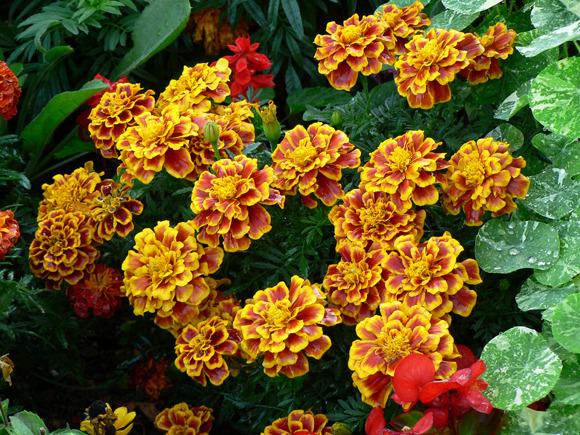
The most common varieties:upright marigolds ( Tagetes erecta) — grow quickly and reach heights from 30 cm to 1 m; leaves and inflorescences are large, flowering later
marigolds rejected (Tagetes patula) is a compact, dwarf, a height of from 20 to 45 cm, with simple and double flowers solid color or two tone colors
marigold fine leaved (Tagetes tenuifolia syn. Tagetes signata) — characteristic of a small growth from 15 to 40 cm), elegant leaves; profuse flowering.
Features of cultivation. Marigolds light-requiring, drought resistant, grow well in any soil, but best on fertile and well-drained. Propagated by seeds, through seedlings and planting in a permanent place; give viable self-seeding. In a flourishing condition are indispensable crop for the repair of flower beds, because it can easily tolerate a transplant. Planted with the distance between plants 20 to 40 cm; seeding depth of 1.5-3 cm, with late planting — up to 5 cm it side by side with any plants. Almost naked are not damaged by slugs.
This is interesting. The genus name comes from the Latin tageticus associated with the ancient God of divination of the Tagus (Tagus), was the grandson of Jupiter. According to ancient mythology, he suddenly emerged from a furrow during plowing and taught people to predict the future, to find buried treasure.
For many students of biological specialties Tagetes sheet – exam care: losers call this a leaf odd-pinnate, and excellence – pinnate. And that flower is the national indicator of the Ukrainian people, who calls him "chernobrivtsy". The famous song which begins with the words "Chernobrivtsy have nasial mats..." is still popular and used by musicians even in a jazz treatment.
The oil from garlic has very strong antiseptic and antimicrobial activity. It is used in the treatment of influenza, upper respiratory tract infections. Its fragrance is recommended for nervousness, it acts relaxing and warming, helps to perceive everything that happens to you in life more calmly. Diuretic, vermifuge. To apply, in consultation with the attending physician
Verbena
Verbena — a very beautiful annual, Rastelli their flower carpets on the beds, perennial borders, rockeries. Flowering her so exquisitely that will not leave anyone indifferent. This verbena variety is good in flower beds, in rockeries, in containers on balconies; can be grown in a basket shape. Suitable for cutting.
Hybrid verbena (Verbena x hybrida syn. V. x hortensis) is a perennial plant, often grown as an annual, up to 45 cm Leaves are dark-green, 5-10 cm Flowers small, in umbellate inflorescences with a diameter of 8 cm, fragrant, white, pink, red, yellow, purple violet, each usually with a white eye; bloom in early July and bloom until late frosts.
Features of cultivation. Verbena photophilous, grows well in fertile, air-penetrable soils with regular watering and fertilizing complete mineral fertilizer. Propagated by seed with the planting of their seedlings in late March – early April.
This is interesting. Finest hour vervain in horticulture came in the nineteenth century, when it was an indispensable plant each adjoining flower garden. The genus name is derived from the Latin word verbenaca – verbena.
Get of verbena essential oil, which acts positively: relieves fatigue, irritability and apathy, displays the depressed psychological state. In addition, it optimizes mental activity, especially creative and logical sides of thinking. Lets spasserovannye of brain vessels, improves blood circulation, eliminates headaches, dizziness, nausea, spasmodic origin. An effective means against the vascular destanie and fatigue. Normalizes blood pressure. To apply, in consultation with the attending physician.
In nursing mothers increases lactation. Rejuvenates, tightens and smoothes the skin, eliminates sagging skin. Improves elasticity problem areas of the body in women: hips, buttocks, abdomen, bust. Verbena – fine erotic stimulant, awakening sensuality and mutual attraction.
Hydrangea
Luxury flowering hydrangeas in July, the mesmerizing beauty of a large spherical inflorescences, which are gradually changing from green to colored. Regal flower, the giver joyful and festive mood. Very romantic now the corners of cottages, buried in pink foam fantastic flower sea of hydrangeas. Hydrangea good in flower, group planting and free-growing, flowering hedges. The inflorescence is used in vase life; often a part of a bouquet for the bride.
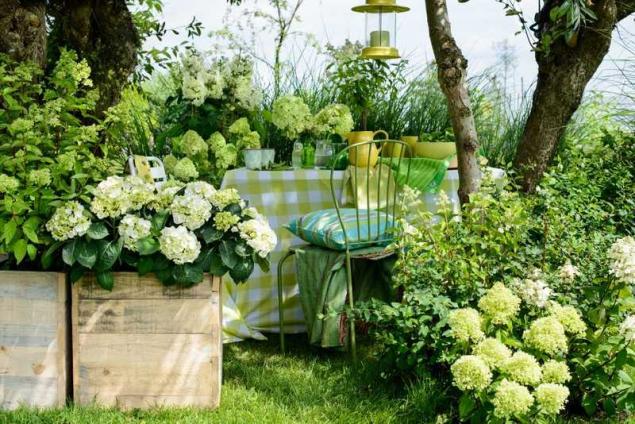
Bigleaf hydrangea or garden (Hydrangea macrophylla) is a low deciduous shrub that grows to an average of 2 m. the Leaves are dark green, ovate, to 20 cm Flowers, not giving fruit, pink, and giving the fruits are purple, sometimes blue, rarely white, bloom in July-August. There are a large number of varieties and forms. Is growing quickly.
Features of cultivation. In the middle zone of Russia hydrangea has low winter-hardiness. Light-requiring, tolerate partial shade, soil requirements and moisture. It is easily propagated by seeds (without incorporation, under glass), green and woody cuttings, layering, suckers, division of the Bush varieties — vegetative. Prefers fertile, moist non-alkaline soil. Rarely damaged by aphids, spider mites, vine weevil, scale insects and affected gray mold, powdery mildew.
This is interesting. The Botanical name of the genus hydrangea - hydrangea — comes from Greek and translates as a lover of the water and this fact – the reality.
Morning glory
Gorgeous annual vine, "waking up" with the first rays of the morning sun. The morning glory is widely used in vertical gardening. Beautiful flower pyramid from Ipomoea purpurea. It is good in the design of the trellis, Windows, porches, gazebos, where it creates a thick green screen with beautiful flowers gramotnymi.
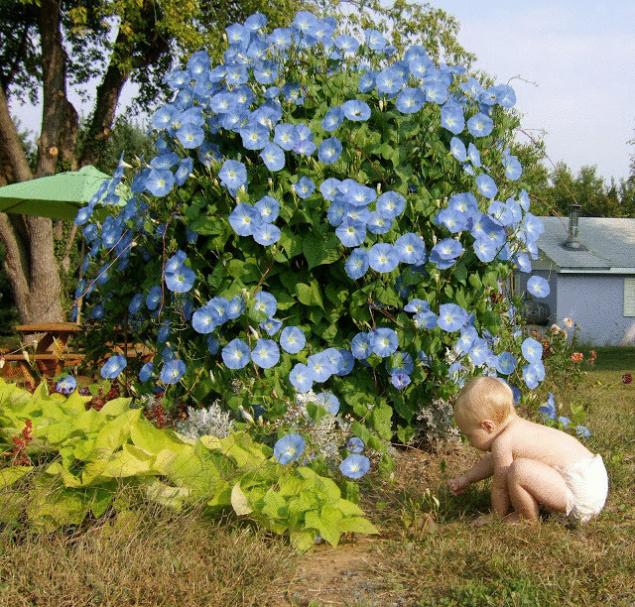
Purple morning glory (Ipomoea purpurea) is a climbing, annual plant of the family Vukovich, reaching a height of 3-4 m. was formerly widespread. Flowers gramophonedzie, pure Magenta color, diameter 5 — 7 cm; in the morning bloom in July-August. Dull green hairy heart-shaped leaves forming a dense drape. Known varieties with pink, blue and white flowers.
Features of cultivation. Light, responsive to irrigation and fertilization; may damage spider mites. Seeds are sown in mid-April in the open ground at a distance of 4-5 cm from each other. Seeds germinate in 5 days. Gives self-seeding. Almost naked is not damaged by slugs.
This is interesting. The genus name comes from the Latinized Greek words: ips — bindweed and'omois – like, similar to bindweed. This morning glory was introduced into cultivation in Europe from North America in 1629 campsis (TECOM)
Campsis is a beautiful vine for vertical gardening, which has many modern varieties of yellow, almost red, orange. It is especially good on fences, trellis, walls protected southern exposure.
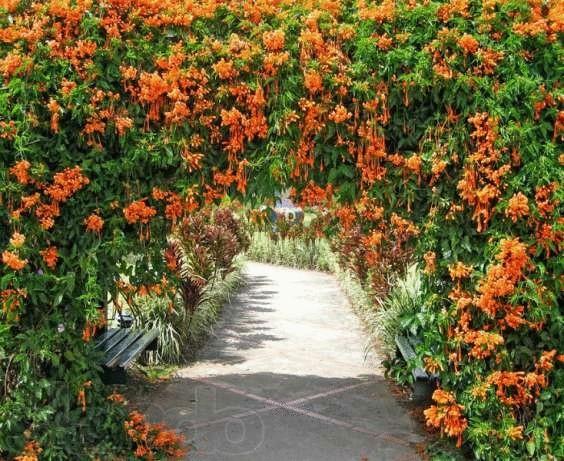
Campsis rooting, or rooting tecoma (Campsis radicans, syn. Tecoma radicans) is a fast growing deciduous vine from the family bignonieae length of 10-15 m, the shoots which are equipped with aerial roots, suckers. The leaves are dark green, shiny, comprising of 7-11 ovate-oblong leaflets 2.5-10 cm Flowers are bright orange, tubular, dense, like a non-living, collected at 5-7 in clusters at the ends of the young shoots; blooming from June to September. Fruit – large copper strockbine box, length 12 cm, ripen in October-December. Features of cultivation. In Central Russia and in the more Northern regions campsis needs a winter shelter, though, and can withstand temperatures down to -25 °C. It is light-requiring, prefers fertile, moderately moist soil in hot, dry summers requires regular watering. Can be damaged by aphids, scale insects, whiteflies and root mildew, leaf spot. Propagated from stratified (2 months) seeds, softwood and root cuttings, layering.
This is interesting. If you have the temptation to dry the wax flowers of campsis for arrangements, then this will be difficult: they turn black, and to achieve the goal it is necessary to make a multilayered strip of absorbent paper. Lavender Lavender is good in group plantings and free-growing, flowering, honey, medicinal borders with the placement of plants in a row in 20-30 cm; double row planting with a row spacing of 40 cm), also suitable for growing over the slopes. One of the most popular ways to use lavender borders — planting them around the roses. They hide the bare ground around the roses, delicately accentuate their gray greens colors of each rose Bud, and also deters aphids.
Lavender angustifolia (Lavandula angustifolia) is a densely branched shrub of the family Labiatae yasnotkovyh or height up to 80 cm Leaves are bluish-green, the flowers are fragrant, small, blue to purple tones, rarely white-pink, collected in small whorls, which form an intermittent spike-like blossoms; in bloom June-August. Fruits – nuts. Long blooming, melliferous, decorative, fragrant, aromatic plants. Features of cultivation. In Central Russia may spend the winter under the snow or in the shelter of spruce branches, can withstand temperatures down to -25 °C. Photophilous, drought-resistant, not demanding to soils, sensitive to waterlogging, excess of urea. Resistant to pests and diseases. Propagated by cuttings. Renewal pruning lavender carried out in the spring: shoots cut to the woody parts. After such pruning the plant becomes more branched and becoming even more magnificent. However, we must be careful: too early pruning in the spring can damage fresh cuts late frosts, and too late may remove the dormant flower buds and reduce the profusion of flowering. In areas with early autumn frosts pruning carried out in early September, to prevent damage to young shoots.
This is interesting. Since Roman times lavender was highly prized as an extract for baths or saunas. Now popular in aromatherapy. Lavender oil is an excellent antispasmodic, analgesic, choleretic, diuretic, diaphoretic, anthelmintic, anti-inflammatory agent. It has healing, antiseptic, kills parasites, insects. Enhances immunity in infectious diseases. Helps with burns, soothes pain, leaving further scars. Aligns the pulse, eliminates tachycardia. A mild antispasmodic. Removes waste products. Petunia Famous Petunia — annual luxury with a rich palette of monochrome, dichroic colors of flowers; the double varieties. Appreciated thanks to a spectacular long lasting flowering until the first frosts. Good in beds, borders, container and basket making.
Petunia garden, or hybrid (Petunia x hybrida) is a perennial herbaceous plant of the family Solanaceae, which is often grown as an annual. It is highly branched creeping shoots with a height of 20-75 cm, the leaves are simple, slightly pubescent, gummy, flowers funnel-shaped, large, with a diameter of 4-13 see, There are many modern varieties and Sartori.Features of cultivation. Petunia unpretentious, but light. Prefers loose fertile soil. Responsive to regular watering and fertilizing with a special fertilizer for petunias and surfinias. The flowers can be damaged by rain, hail; wet summer may be affected by rot. Propagated through seedlings seeds; some of the double varieties are green cuttings. Almost naked are not damaged by slugs, but suffer from powdery mildew.
This is interesting. The genus name comes from the word petun – the so-Brazil called tobacco, Botanical similarity. Stock-rose, or mallow Malva is a beautiful large plant with stalks-candles, consisting of blossoming, like a tutu ballerina (double varieties), showy flowers for a long time. A favorite of many plants for the decoration of cottages in a rustic style. Particularly impressive will look at the background of the hedge type fence. Good in group plantings against the house, fence, and mixborders as tall prima. The big advantage is its ability to not lose decorativeness in one place for 4-5 years. Looks good in the cut.
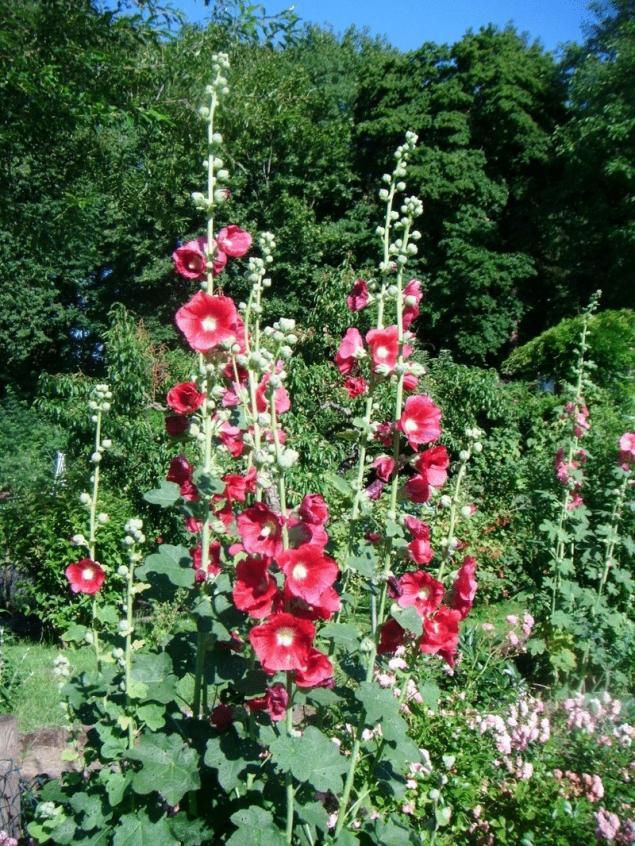
Stock-rose pink or Malva sylvestris, garden (Alcea rosea, syn. Althaea rosea) is a perennial pubescent herb of the family Malvaceae, commonly grown as a biennial, forming in the 1st year rosette of leaves, and on the 2nd year – the stem-peduncle height from 80 cm to 2-3 m. Flowers are large, with a diameter of 6-12 cm, white, yellow, pink, red to almost black, gathered at 1-2 in the leaf axils, forming a very long, terminal spike-like inflorescence; bloom in July-September. Fruits – prefabricated; ripen in July-September. There are ornamental varieties of simple, double, of various colors.Features of cultivation. Low light conditions, drought tolerant. Prefers fertile, light, deeply worked soil. Gives self-seeding. Propagated by seeds, through seedlings. Planted with a spacing of 40-50 cm. Damaged bare slugs.
This is interesting. The genus name is derived from the Latin word altaea is a wild mallow, borrowed from Greek, where altheo to heal, because this plant has long been regarded as medicinal. Cultivated food, medicinal, ornamental plant. Do eat flowers (especially black color) food dye of red color for beverages, herbal teas, confectionery, etc. With the purpose of treatment using flowers, roots rarely as an anti-inflammatory, demulcent, expectorant, enveloping, astringent, as well as in gynecology. Josam Extremely attractive with a bell, opening widely the secret of his "soul." The plant is so spectacular that significantly pushed the usual bells with their honorary first place in leaders blue. Flower widely open, like a locator, and the bells he often has teeth, curved in the opposite direction. Appearing above ground leafless young spring shoots are also the intense blue color; the bluish sheen will perfectly contrast with the deep green and salad shades of green of other plants. Recommended for small group plantings in rockeries, on slopes, in mixborders, flower bed as a focal or an accompanying element.
Josam grandiflorum (Platycodon grandiflorus) is an herbaceous perennial, which many erroneously consider a bell (Campanula) from the family campanulaceae, with a height up to 70 cm Flowers are large, with a diameter of 7 cm, blue, rarely white or pink, solitary or in few-flowered racemes; bloom in July-August (September). Fruit – capsule; ripen in August-September. There are decorative varieties and forms.Features of cultivation. Light-requiring, but grows well in partial shade in loose, fertile soils. Propagated by seeds, through seedlings. At one point rising more than 10 years, so that problems with transfer will not, especially if you add fresh soil. The plants need to be planted keeping a distance of 25-30 cm, and seeds close up on depth 5 see Damaged bare slugs.
This is interesting. The genus name comes from the Latinized Greek words platos – wide, flat, and codon – bell, in the shape of a flower. Josam is not just decorative, but also vegetable and medicinal value. Delicious fresh, pickled, candied young roots with a little bitterness. The Koreans use for their soups, which add sugar or vinegar. For over 2000 years because of the content in the roots of josam phytosterol, saponin, inulin, it is used in Chinese and Korean medicine for bronchitis, coughs, pneumonia, respiratory diseases, tonsillitis. They possess expectorant, tonic, anti-inflammatory action.
Source: www.7dach.ru
Begonia Vale of eternal blossoms, or sagacity (Begonia x semperflorens) is a perennial herbaceous plant from the same family of begonia, grown often as an annual, 15-30 cm tall with succulent stems gustovataja. The leaves are large, heart-shaped, shiny green and bronze varieties. The flowers are small, with a diameter of 3 cm, white, pink, red, simple and double. Flowering is very long, until frost.Features of cultivation. Begonia light-requiring, but can tolerate partial shade, not picky about soil, but luxurious blooms only on loose fertile; responsive to regular watering and fertilizing (especially when growing in containers, pots). Propagated by seeds (sowing the surface in January) through seedlings and cuttings, dividing plants, which is especially easy to do in country conditions: the forgotten bouquet of begonias will give a "beard" roots in 1-2 weeks.
Photo By Anton PapkovMarigolds
Any other annuals not give us so much joy and warmth, as popularly loved marigolds. They bloom until the first frost. Especially prized due to their medicinal and healing in relation to other plant characteristics. They are good in mixborders, flowerbed, ridges, spicy garden, in dense borders along paths in the form of bright edges of garden beds. Dwarf varieties of marigold suitable for planting in rockeries as focal or accompanying elements, in addition, they are long standing in the cut.

The most common varieties:upright marigolds ( Tagetes erecta) — grow quickly and reach heights from 30 cm to 1 m; leaves and inflorescences are large, flowering later
marigolds rejected (Tagetes patula) is a compact, dwarf, a height of from 20 to 45 cm, with simple and double flowers solid color or two tone colors
marigold fine leaved (Tagetes tenuifolia syn. Tagetes signata) — characteristic of a small growth from 15 to 40 cm), elegant leaves; profuse flowering.
Features of cultivation. Marigolds light-requiring, drought resistant, grow well in any soil, but best on fertile and well-drained. Propagated by seeds, through seedlings and planting in a permanent place; give viable self-seeding. In a flourishing condition are indispensable crop for the repair of flower beds, because it can easily tolerate a transplant. Planted with the distance between plants 20 to 40 cm; seeding depth of 1.5-3 cm, with late planting — up to 5 cm it side by side with any plants. Almost naked are not damaged by slugs.
This is interesting. The genus name comes from the Latin tageticus associated with the ancient God of divination of the Tagus (Tagus), was the grandson of Jupiter. According to ancient mythology, he suddenly emerged from a furrow during plowing and taught people to predict the future, to find buried treasure.
For many students of biological specialties Tagetes sheet – exam care: losers call this a leaf odd-pinnate, and excellence – pinnate. And that flower is the national indicator of the Ukrainian people, who calls him "chernobrivtsy". The famous song which begins with the words "Chernobrivtsy have nasial mats..." is still popular and used by musicians even in a jazz treatment.
The oil from garlic has very strong antiseptic and antimicrobial activity. It is used in the treatment of influenza, upper respiratory tract infections. Its fragrance is recommended for nervousness, it acts relaxing and warming, helps to perceive everything that happens to you in life more calmly. Diuretic, vermifuge. To apply, in consultation with the attending physician
Verbena
Verbena — a very beautiful annual, Rastelli their flower carpets on the beds, perennial borders, rockeries. Flowering her so exquisitely that will not leave anyone indifferent. This verbena variety is good in flower beds, in rockeries, in containers on balconies; can be grown in a basket shape. Suitable for cutting.
Hybrid verbena (Verbena x hybrida syn. V. x hortensis) is a perennial plant, often grown as an annual, up to 45 cm Leaves are dark-green, 5-10 cm Flowers small, in umbellate inflorescences with a diameter of 8 cm, fragrant, white, pink, red, yellow, purple violet, each usually with a white eye; bloom in early July and bloom until late frosts.
Features of cultivation. Verbena photophilous, grows well in fertile, air-penetrable soils with regular watering and fertilizing complete mineral fertilizer. Propagated by seed with the planting of their seedlings in late March – early April.
This is interesting. Finest hour vervain in horticulture came in the nineteenth century, when it was an indispensable plant each adjoining flower garden. The genus name is derived from the Latin word verbenaca – verbena.
Get of verbena essential oil, which acts positively: relieves fatigue, irritability and apathy, displays the depressed psychological state. In addition, it optimizes mental activity, especially creative and logical sides of thinking. Lets spasserovannye of brain vessels, improves blood circulation, eliminates headaches, dizziness, nausea, spasmodic origin. An effective means against the vascular destanie and fatigue. Normalizes blood pressure. To apply, in consultation with the attending physician.
In nursing mothers increases lactation. Rejuvenates, tightens and smoothes the skin, eliminates sagging skin. Improves elasticity problem areas of the body in women: hips, buttocks, abdomen, bust. Verbena – fine erotic stimulant, awakening sensuality and mutual attraction.
Hydrangea
Luxury flowering hydrangeas in July, the mesmerizing beauty of a large spherical inflorescences, which are gradually changing from green to colored. Regal flower, the giver joyful and festive mood. Very romantic now the corners of cottages, buried in pink foam fantastic flower sea of hydrangeas. Hydrangea good in flower, group planting and free-growing, flowering hedges. The inflorescence is used in vase life; often a part of a bouquet for the bride.

Bigleaf hydrangea or garden (Hydrangea macrophylla) is a low deciduous shrub that grows to an average of 2 m. the Leaves are dark green, ovate, to 20 cm Flowers, not giving fruit, pink, and giving the fruits are purple, sometimes blue, rarely white, bloom in July-August. There are a large number of varieties and forms. Is growing quickly.
Features of cultivation. In the middle zone of Russia hydrangea has low winter-hardiness. Light-requiring, tolerate partial shade, soil requirements and moisture. It is easily propagated by seeds (without incorporation, under glass), green and woody cuttings, layering, suckers, division of the Bush varieties — vegetative. Prefers fertile, moist non-alkaline soil. Rarely damaged by aphids, spider mites, vine weevil, scale insects and affected gray mold, powdery mildew.
This is interesting. The Botanical name of the genus hydrangea - hydrangea — comes from Greek and translates as a lover of the water and this fact – the reality.
Morning glory
Gorgeous annual vine, "waking up" with the first rays of the morning sun. The morning glory is widely used in vertical gardening. Beautiful flower pyramid from Ipomoea purpurea. It is good in the design of the trellis, Windows, porches, gazebos, where it creates a thick green screen with beautiful flowers gramotnymi.

Purple morning glory (Ipomoea purpurea) is a climbing, annual plant of the family Vukovich, reaching a height of 3-4 m. was formerly widespread. Flowers gramophonedzie, pure Magenta color, diameter 5 — 7 cm; in the morning bloom in July-August. Dull green hairy heart-shaped leaves forming a dense drape. Known varieties with pink, blue and white flowers.
Features of cultivation. Light, responsive to irrigation and fertilization; may damage spider mites. Seeds are sown in mid-April in the open ground at a distance of 4-5 cm from each other. Seeds germinate in 5 days. Gives self-seeding. Almost naked is not damaged by slugs.
This is interesting. The genus name comes from the Latinized Greek words: ips — bindweed and'omois – like, similar to bindweed. This morning glory was introduced into cultivation in Europe from North America in 1629 campsis (TECOM)
Campsis is a beautiful vine for vertical gardening, which has many modern varieties of yellow, almost red, orange. It is especially good on fences, trellis, walls protected southern exposure.

Campsis rooting, or rooting tecoma (Campsis radicans, syn. Tecoma radicans) is a fast growing deciduous vine from the family bignonieae length of 10-15 m, the shoots which are equipped with aerial roots, suckers. The leaves are dark green, shiny, comprising of 7-11 ovate-oblong leaflets 2.5-10 cm Flowers are bright orange, tubular, dense, like a non-living, collected at 5-7 in clusters at the ends of the young shoots; blooming from June to September. Fruit – large copper strockbine box, length 12 cm, ripen in October-December. Features of cultivation. In Central Russia and in the more Northern regions campsis needs a winter shelter, though, and can withstand temperatures down to -25 °C. It is light-requiring, prefers fertile, moderately moist soil in hot, dry summers requires regular watering. Can be damaged by aphids, scale insects, whiteflies and root mildew, leaf spot. Propagated from stratified (2 months) seeds, softwood and root cuttings, layering.
This is interesting. If you have the temptation to dry the wax flowers of campsis for arrangements, then this will be difficult: they turn black, and to achieve the goal it is necessary to make a multilayered strip of absorbent paper. Lavender Lavender is good in group plantings and free-growing, flowering, honey, medicinal borders with the placement of plants in a row in 20-30 cm; double row planting with a row spacing of 40 cm), also suitable for growing over the slopes. One of the most popular ways to use lavender borders — planting them around the roses. They hide the bare ground around the roses, delicately accentuate their gray greens colors of each rose Bud, and also deters aphids.
Lavender angustifolia (Lavandula angustifolia) is a densely branched shrub of the family Labiatae yasnotkovyh or height up to 80 cm Leaves are bluish-green, the flowers are fragrant, small, blue to purple tones, rarely white-pink, collected in small whorls, which form an intermittent spike-like blossoms; in bloom June-August. Fruits – nuts. Long blooming, melliferous, decorative, fragrant, aromatic plants. Features of cultivation. In Central Russia may spend the winter under the snow or in the shelter of spruce branches, can withstand temperatures down to -25 °C. Photophilous, drought-resistant, not demanding to soils, sensitive to waterlogging, excess of urea. Resistant to pests and diseases. Propagated by cuttings. Renewal pruning lavender carried out in the spring: shoots cut to the woody parts. After such pruning the plant becomes more branched and becoming even more magnificent. However, we must be careful: too early pruning in the spring can damage fresh cuts late frosts, and too late may remove the dormant flower buds and reduce the profusion of flowering. In areas with early autumn frosts pruning carried out in early September, to prevent damage to young shoots.
This is interesting. Since Roman times lavender was highly prized as an extract for baths or saunas. Now popular in aromatherapy. Lavender oil is an excellent antispasmodic, analgesic, choleretic, diuretic, diaphoretic, anthelmintic, anti-inflammatory agent. It has healing, antiseptic, kills parasites, insects. Enhances immunity in infectious diseases. Helps with burns, soothes pain, leaving further scars. Aligns the pulse, eliminates tachycardia. A mild antispasmodic. Removes waste products. Petunia Famous Petunia — annual luxury with a rich palette of monochrome, dichroic colors of flowers; the double varieties. Appreciated thanks to a spectacular long lasting flowering until the first frosts. Good in beds, borders, container and basket making.
Petunia garden, or hybrid (Petunia x hybrida) is a perennial herbaceous plant of the family Solanaceae, which is often grown as an annual. It is highly branched creeping shoots with a height of 20-75 cm, the leaves are simple, slightly pubescent, gummy, flowers funnel-shaped, large, with a diameter of 4-13 see, There are many modern varieties and Sartori.Features of cultivation. Petunia unpretentious, but light. Prefers loose fertile soil. Responsive to regular watering and fertilizing with a special fertilizer for petunias and surfinias. The flowers can be damaged by rain, hail; wet summer may be affected by rot. Propagated through seedlings seeds; some of the double varieties are green cuttings. Almost naked are not damaged by slugs, but suffer from powdery mildew.
This is interesting. The genus name comes from the word petun – the so-Brazil called tobacco, Botanical similarity. Stock-rose, or mallow Malva is a beautiful large plant with stalks-candles, consisting of blossoming, like a tutu ballerina (double varieties), showy flowers for a long time. A favorite of many plants for the decoration of cottages in a rustic style. Particularly impressive will look at the background of the hedge type fence. Good in group plantings against the house, fence, and mixborders as tall prima. The big advantage is its ability to not lose decorativeness in one place for 4-5 years. Looks good in the cut.

Stock-rose pink or Malva sylvestris, garden (Alcea rosea, syn. Althaea rosea) is a perennial pubescent herb of the family Malvaceae, commonly grown as a biennial, forming in the 1st year rosette of leaves, and on the 2nd year – the stem-peduncle height from 80 cm to 2-3 m. Flowers are large, with a diameter of 6-12 cm, white, yellow, pink, red to almost black, gathered at 1-2 in the leaf axils, forming a very long, terminal spike-like inflorescence; bloom in July-September. Fruits – prefabricated; ripen in July-September. There are ornamental varieties of simple, double, of various colors.Features of cultivation. Low light conditions, drought tolerant. Prefers fertile, light, deeply worked soil. Gives self-seeding. Propagated by seeds, through seedlings. Planted with a spacing of 40-50 cm. Damaged bare slugs.
This is interesting. The genus name is derived from the Latin word altaea is a wild mallow, borrowed from Greek, where altheo to heal, because this plant has long been regarded as medicinal. Cultivated food, medicinal, ornamental plant. Do eat flowers (especially black color) food dye of red color for beverages, herbal teas, confectionery, etc. With the purpose of treatment using flowers, roots rarely as an anti-inflammatory, demulcent, expectorant, enveloping, astringent, as well as in gynecology. Josam Extremely attractive with a bell, opening widely the secret of his "soul." The plant is so spectacular that significantly pushed the usual bells with their honorary first place in leaders blue. Flower widely open, like a locator, and the bells he often has teeth, curved in the opposite direction. Appearing above ground leafless young spring shoots are also the intense blue color; the bluish sheen will perfectly contrast with the deep green and salad shades of green of other plants. Recommended for small group plantings in rockeries, on slopes, in mixborders, flower bed as a focal or an accompanying element.
Josam grandiflorum (Platycodon grandiflorus) is an herbaceous perennial, which many erroneously consider a bell (Campanula) from the family campanulaceae, with a height up to 70 cm Flowers are large, with a diameter of 7 cm, blue, rarely white or pink, solitary or in few-flowered racemes; bloom in July-August (September). Fruit – capsule; ripen in August-September. There are decorative varieties and forms.Features of cultivation. Light-requiring, but grows well in partial shade in loose, fertile soils. Propagated by seeds, through seedlings. At one point rising more than 10 years, so that problems with transfer will not, especially if you add fresh soil. The plants need to be planted keeping a distance of 25-30 cm, and seeds close up on depth 5 see Damaged bare slugs.
This is interesting. The genus name comes from the Latinized Greek words platos – wide, flat, and codon – bell, in the shape of a flower. Josam is not just decorative, but also vegetable and medicinal value. Delicious fresh, pickled, candied young roots with a little bitterness. The Koreans use for their soups, which add sugar or vinegar. For over 2000 years because of the content in the roots of josam phytosterol, saponin, inulin, it is used in Chinese and Korean medicine for bronchitis, coughs, pneumonia, respiratory diseases, tonsillitis. They possess expectorant, tonic, anti-inflammatory action.
Source: www.7dach.ru



